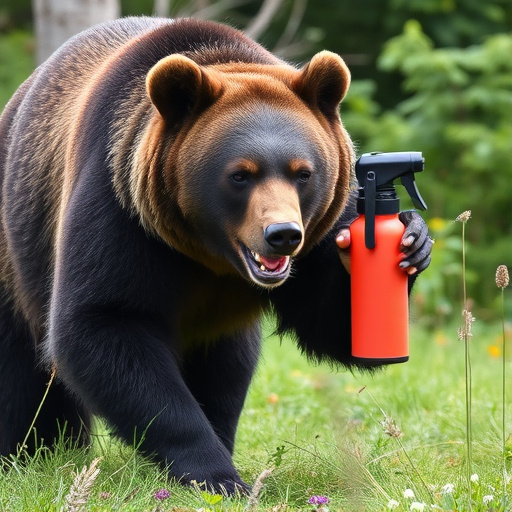Understanding bear behavior is key for safety in wilderness areas with bear populations. Bear spray is vital, but accidental discharge must be prevented through proper handling, storage (upside down, secure, out of direct sunlight), and technique (aiming at face or eyes, checking wind direction). Regular maintenance checks, user training, and securing the can are critical. After encounters, check gear for accidental discharge and contact local authorities. Prioritizing safety ensures individual protection and minimizes risks to others.
In the vast wilderness, encountering a bear can range from a fleeting moment to a life-threatening situation. Understanding bear behavior is paramount for safety in remote areas. This article equips readers with essential knowledge and practical techniques for bear attack protection. We explore the effectiveness of bear spray as a defense mechanism, focusing on preventing accidental discharge. Additionally, storage tips and post-encounter measures are highlighted to ensure survivors know when and how to seek help.
- Understanding Bear Behavior: Key to Safety
- The Role of Bear Spray in Defense
- Accidental Discharge Prevention Techniques
- Proper Storage and Handling Practices
- Post-Encounter Safety Measures and When to Seek Help
Understanding Bear Behavior: Key to Safety
Understanding bear behavior is crucial for anyone venturing into wilderness areas known to harbor these majestic creatures. Bears, especially grizzly bears and black bears, are typically shy and avoid human contact, only attacking when they feel threatened or surprised. Key behaviors to remember include: a mother bear protecting her cubs, bears seeking food sources like berries or trash, and accidental discharges of bear spray, which can trigger an aggressive response if not handled properly.
To minimize the risk of a bear attack, it’s essential to prevent accidental bear spray discharge. Always check the direction of wind before using bear spray, aim for the bear’s face, and ensure you have a clear line of sight. Proper storage and handling techniques are also critical. Keep bear spray within reach but out of direct sunlight, and familiarize yourself with its operation to avoid unexpected discharges.
The Role of Bear Spray in Defense
Bear spray is a critical component of wilderness survival, particularly in areas known for bear populations. Its effectiveness lies in its ability to deter and incapacitate bears during an attack, providing precious time for escape or assistance to arrive. The key to maximizing its utility is proper handling and understanding how to use it effectively, including preventing accidental discharges.
Accidental bear spray discharge can be avoided by following simple precautions. Keeping the can in a secure, closed container until needed, practicing regular maintenance checks, and ensuring all users are trained on usage protocols are essential steps. By prioritizing these measures, individuals can ensure they have a reliable defense mechanism against bears while minimizing the risk of accidental deployment.
Accidental Discharge Prevention Techniques
In any potential bear encounter, preventing an accidental discharge of your bear spray is paramount to ensuring safety and effectiveness. It’s crucial to maintain control over the nozzle and trigger, especially during high-stress situations. Practice proper handling techniques, such as keeping the canister in a secure holster or pouch designed for easy access yet firm grip. Always inspect the device before approaching bears, checking for any signs of damage or malfunction that could cause unintentional spraying.
Training and familiarization with the spray’s operation are key. Learn the different types of triggers and how they respond to pressure. Some canisters have a burst of spray upon initial contact, while others require a sustained press. Understanding these mechanisms allows you to respond appropriately, aiming for the bear’s face or eyes if needed, without accidentally unleashing a full blast that could misfire or hit unintended targets.
Proper Storage and Handling Practices
Proper storage and handling practices are essential for ensuring bear spray remains effective during a potential encounter. Keep your bear spray in an easily accessible yet secure location, such as on a belt or in a dedicated container attached to your backpack. Always inspect the device before leaving your campsite or trailhead; ensure the safety strap is intact and the nozzle is free of debris. Regularly check expiration dates, as bear spray can lose its potency over time.
To prevent accidental discharge, handle the spray with care. Store it upside down when not in use to reduce the risk of the trigger being inadvertently activated. Never point the nozzle at yourself or others; keep it aimed towards potential bear threats. Familiarize yourself with the spray’s actuation mechanism and practice using it until you’re comfortable with the motion required to deploy it effectively during an emergency.
Post-Encounter Safety Measures and When to Seek Help
After a bear encounter, it’s crucial to prioritize safety and take immediate action. One critical step is to ensure no accidental discharge of bear spray has occurred. Check your gear and surroundings for any signs of mist or residual spray, as even a minor discharge can attract bears or cause unnecessary panic. If you’ve used bear spray successfully, keep the container on hand; it could be valuable if another encounter arises.
If the encounter was more than a fleeting sight of a bear, or if you were attacked, seek help promptly. Contact local wildlife authorities or emergency services. Provide them with your location, the type and size of the bear, and details about the encounter. They can offer guidance and send professionals to ensure your safety and that of others in the area. Remember, knowing when and how to ask for assistance is a vital part of post-encounter procedures.
Understanding bear behavior and knowing how to properly use bear spray are essential skills for anyone venturing into wild areas. By following the guidelines outlined in this article, including techniques for accidental discharge prevention and proper storage practices, you can significantly enhance your safety during potential bear encounters. Remember, knowledge is your best defense. Stay informed, stay safe, and always respect the wilderness.
